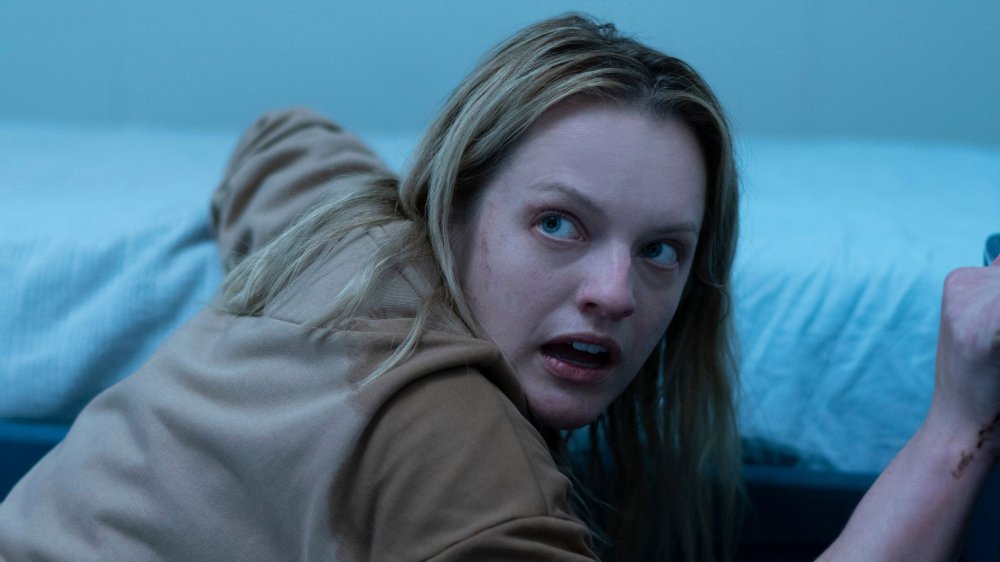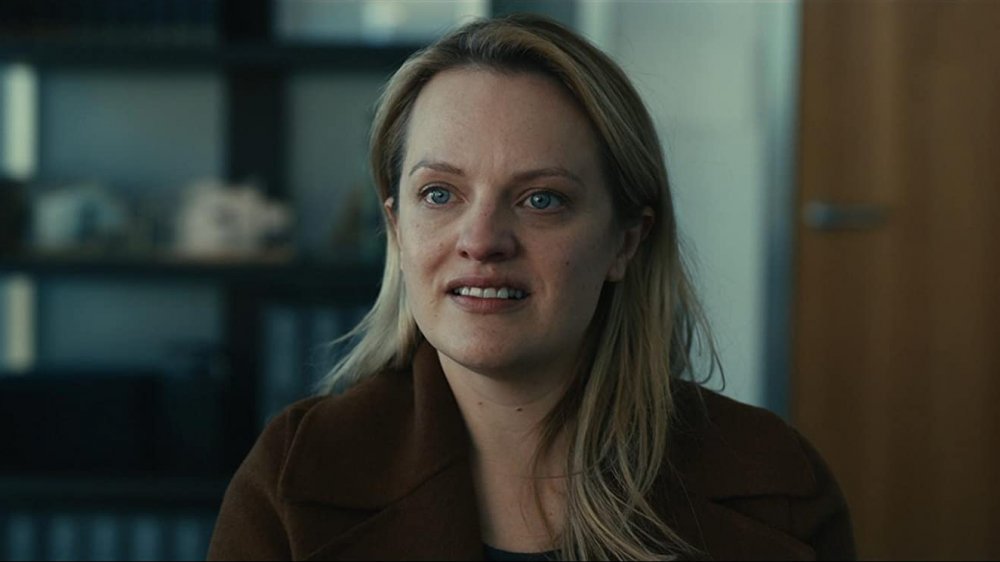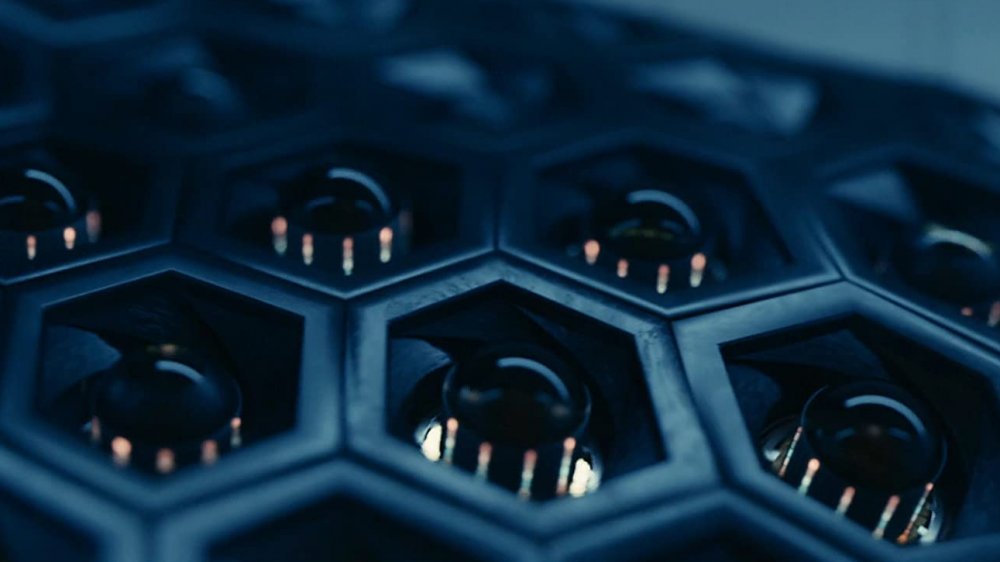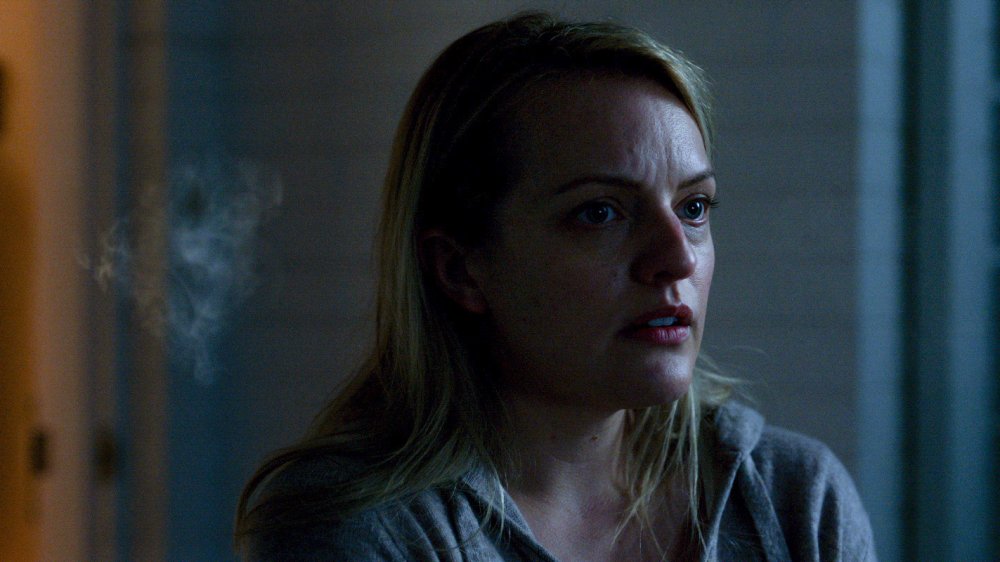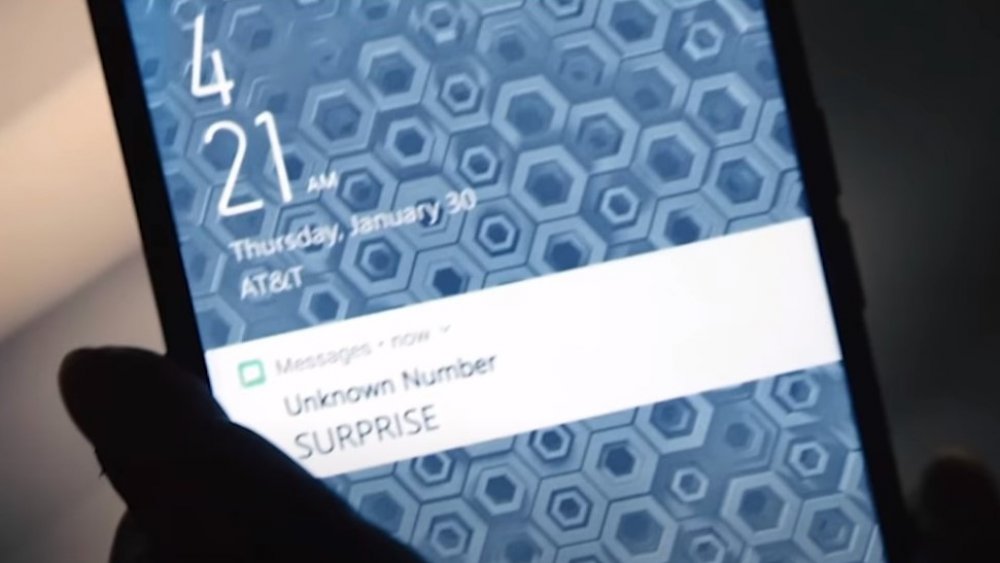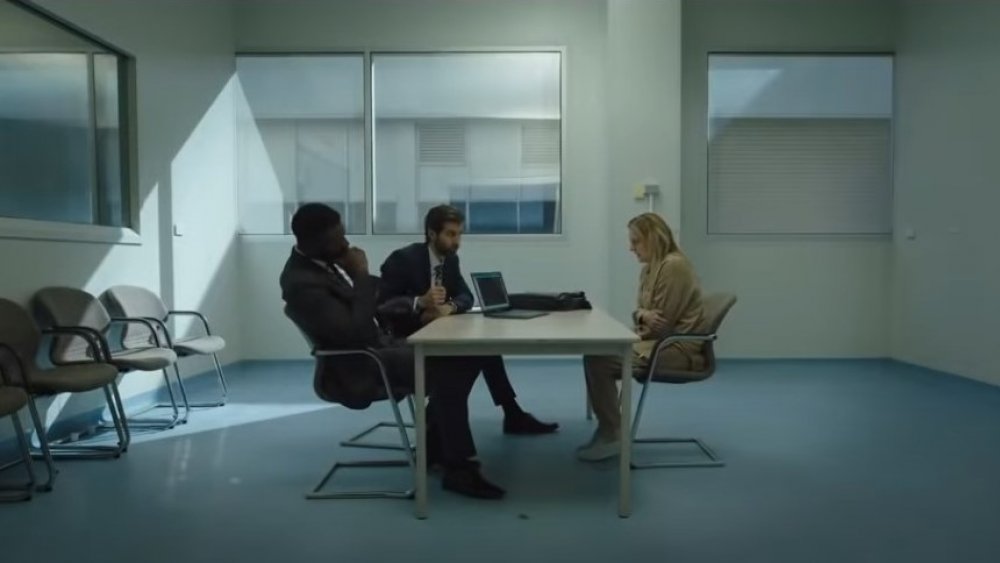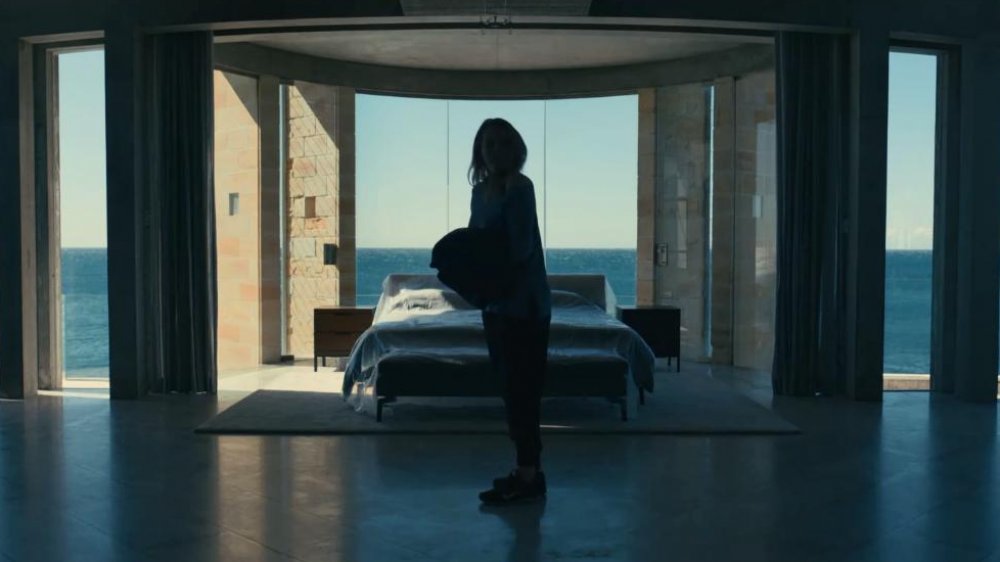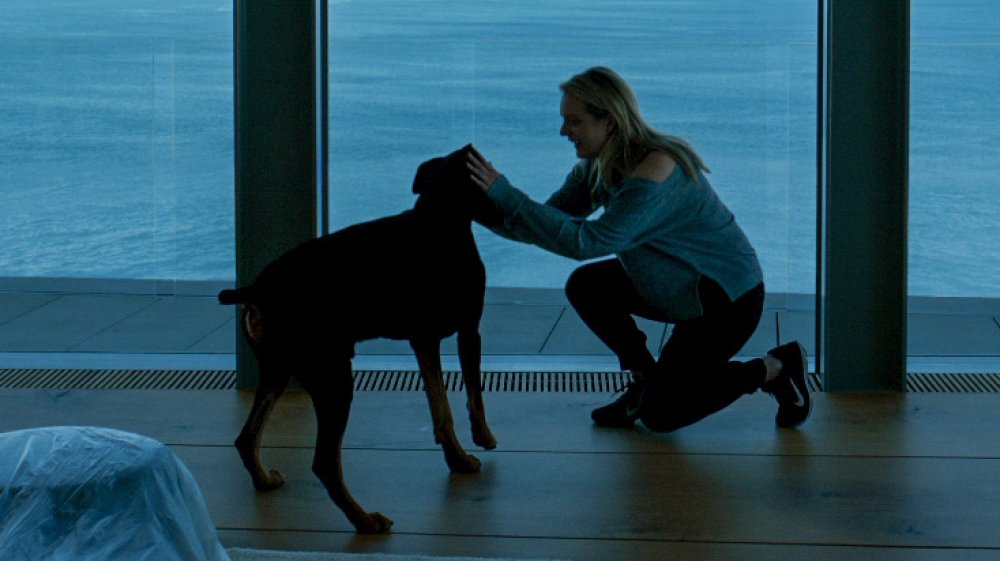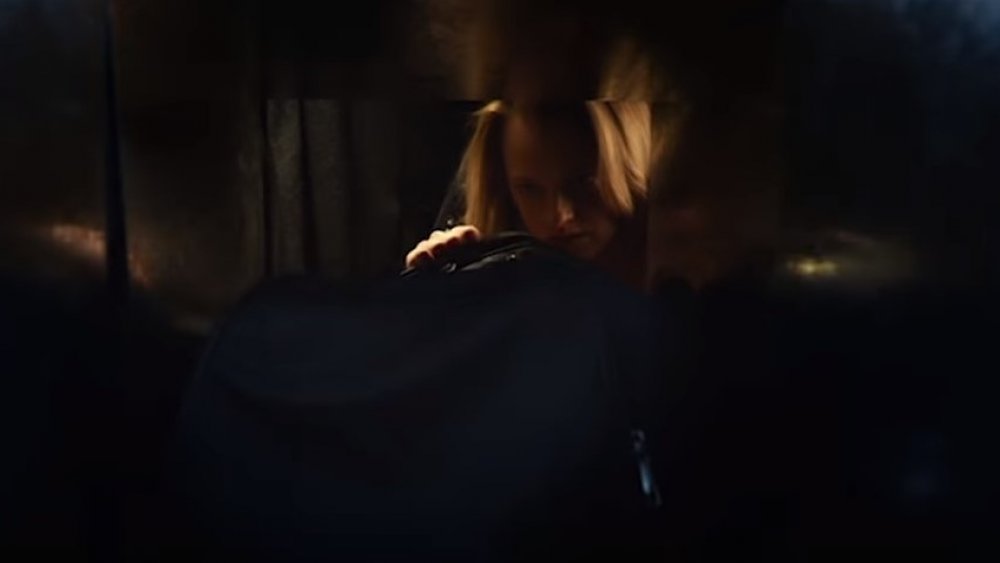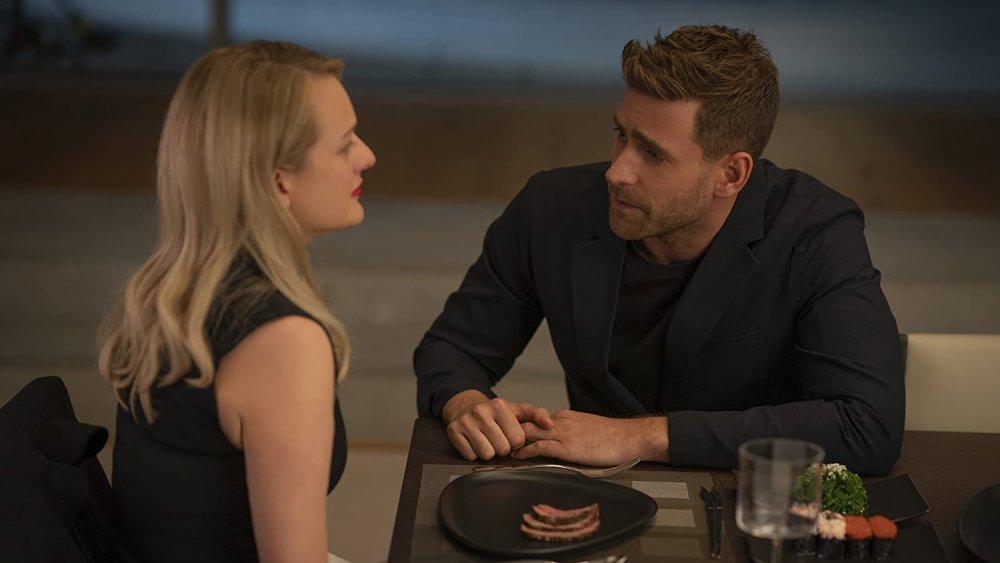Small Details You Missed In The Invisible Man
In 2020, writer/director Leigh Whannell blew the dust off a century-old creation with The Invisible Man, a horror-thriller that updates an iconic monster for modern audiences. But just like the titular character, there's more to this movie than meets the eye.
The Invisible Man first showed up in H.G. Wells' 1897 novel before frightening audiences in James Whale's 1933 film adaptation. But Whannell wisely flipped the script for this version, focusing not on the titular mad scientist but on the woman he victimizes, as well as tightening the story's scope to an abusive relationship. The domestic abuse and gaslighting turned out to be an organic metaphor for a villain who, as Whannell told BuzzFeed, has "the ability to be standing next to you without you knowing it."
But even though you can't see the villain, there's still plenty to notice in Whannell's film. Far from a cheap fright flick, this thoughtful horror film is loaded with metaphors, subtle hints, and all sorts of Easter eggs. If you want to discover the truth about what's secretly right in front of your nose, then get ready for the small details you missed in The Invisible Man.
(Be warned, there are spoilers below.)
What's in a name?
Played to perfection by Elisabeth Moss, the protagonist of The Invisible Man is Cecilia, an abuse survivor with a very telling name. Think about it. Cecilia's nickname is "Cee," pronounced "see," but wait, there's layers to this. The name Cecilia comes from the Latin word caecus meaning "blind," although other sources say Cecilia means "blind to one's own beauty." Either way, what could've been some on-the-nose screenwriting has a deeper meaning here.
Cecilia flees her abusive boyfriend, Adrian (Oliver Jackson-Cohen), in the film's opening moments, then learns he's committed suicide. Of course, he actually hasn't — as a leader in the optics field, Adrian invents a suit that turns the wearer invisible — but Cecilia at first is the only one who suspects her ex is still alive and relentlessly tormenting her. When she insists to her sister, Emily (Harriet Dyer), and her friend, James (Aldis Hodge), that Adrian has somehow found a way to agonize her, they try to soothe her by saying things like, "Cee, he's dead," literally telling her what to see. But Cecilia sees the situation for what it is. After all, she's seen — and knows — how sinister Adrian can be.
Dual optics in The Invisible Man
This film's invisible man, Adrian Griffin, shares the same last name as the character in Wells' story. And like that first Invisible Man, he also devotes himself to researching optics. However, unlike Wells' character, this one doesn't render himself invisible through a chemical process but technology. Being a renowned optics expert enables Adrian to invent a suit that turns whoever wears it invisible, a temporary option that lays the groundwork for some plot twists. (The film never explains exactly how the suit works, but Adrian's implied skill set and our familiarity with technology is enough for viewers to go along with the premise.)
The concept of optics has an additional context within an abusive relationship. Adrian is an expert at appearances. He knows the image he wants his girlfriend to project. "He was in complete control of everything, you know? Including me," Cecilia explains to Emily and James. "He controlled how I looked, what I wore, what I ate. And then it was controlling when I left the house and what I said. And eventually, what I thought." He's also well aware of how Cecilia seems unstable whenever he taunts her without saying a word.
The long reach of The Invisible Man
After his supposed death, Adrian bequeaths Cecilia $5 million, with certain caveats, such as she can't commit a crime. Although plenty of spidey senses probably tingled at that little detail, Cecilia deserves kudos for trying to distance herself from this money. She sets up a bank account for James' daughter, Sydney (Storm Reid), to help pay for the girl's college education, and she hustles to find a steady job. An architect by trade, Cecilia gets an interview at an architecture firm, which Adrian sabotages by emptying her portfolio and drugging her with a sedative that causes her to faint. Although the interview scene is brief, the firm's name — Ruler — appears clearly in red on the wall in the workplace. This may be a stretch, but "Ruler" sounds a lot like "rule her," which is what Adrian wants to do by any measure. After all, Cecilia can't even step outside for air without her invisible ex lurking over her shoulder, as Adrian is all about control and power.
That guy looks kinda familiar
The Invisible Man tips its hat a few times to James Whale's famous film version. Because Sydney is an aspiring fashion designer, she has a white mannequin in her room that wears a wide-brimmed black hat and jacket, much like Invisible Man actor Claude Rains did in the 1933 film, albeit with dark glasses and his face wrapped in bandages. The mannequin rests largely in the background, although it does startle Cecilia during the night when she's convinced that Adrian is nearby.
Later in the film, during a trip to the hospital, Cecilia sees a bandaged man on a gurney, an obvious wink to fans who remember Rains' character unwrapping himself to reveal no face underneath. Incidentally, the book James Whale: A New World of Gods and Monsters describes how Whale and the special effects team achieved this moment through several shots that involved draping the set in black velvet and Rains wearing black tights, black gloves, and a black headpiece. Pretty impressive for the 1930s!
A telling background
While staying with James and Sydney, Cecilia discovers proof that Adrian has been hiding in James' super creepy attic to spy on her. She finds not just the sketches from her architecture portfolio that he stole before her job interview but a bagged kitchen knife that becomes important later, as well as Adrian's smartphone. Up until this point, neither the audience nor Cecilia has glimpsed the invisibility suit or seen Adrian in it. But the film drops a clue and a nice callback (pardon the pun) in the hexagonal pattern on the phone's background display.
The pattern is the same as the screensaver on the computers in Adrian's workshop that viewers might've noticed as Cecilia dashed through the workshop during her escape from their house at the film's beginning. And once the film reveals Adrian's suit, the honeycomb pattern is instantly recognizable as the tiny devices on the outfit's surface that camouflage the wearer. They emit a telltale buzz whenever someone is too close to them, and evidently, Adrian is so obsessed with the look that he's got it plastered across all of his devices.
The Invisible Man accentuates the negative
Leigh Whannell cleverly uses a lot of wide shots and a generous amount of negative space to bolster the film's tension. It sounds like a science fiction term, but negative space in filmmaking is the increased space around and between the subject of a shot. For example, stick a character in the great outdoors, and the empty area around him would be negative space. Filmmakers use negative space to direct viewers where to look, to create comedic effects, or produce a sense of isolation.
And Cecilia definitely feels isolated as the film progresses, but the negative space in The Invisible Man also heightens the suspense by inviting the audience to try and spot Adrian as he tracks Cecilia's moves. Audiences today are "very film literate, even if they don't know they are," Whannell told io9. "So I tried to weaponize that against them. Knowing if I pointed the camera at a corner, in a film called The Invisible Man, the audience is going to start thinking, 'Is he there? Is he not there?' ... They'll automatically be suspicious." So the next time you watch the film, keep an eye out for all the negative space that Whannell employs to make you wonder if Adrian is lurking about, waiting to pounce on our unsuspecting hero.
Two silhouettes, two villains
Adrian's brother, Tom (Michael Dorman), is an attorney who seems sympathetic to Cecilia at first, telling her that Adrian controlled him long before Cecilia showed up. But Adrian couldn't fake his death without help, and when Cecilia winds up in a mental hospital, framed for murder, a poster over Tom's shoulder with two black silhouettes alludes to Cecilia fighting two antagonists.
And it's in this very scene that Tom shows his hand, offering to make the criminal charges against Cecilia vanish if she promises to return to his brother. Once he leaves, Cecilia gazes at the poster, which says, "You don't have to face yourself alone." While this is a fitting sentiment for the hospital, the silhouettes resemble the invisibility suit, and sure enough, Cecilia soon learns in one of the film's twists that Tom has been wearing one, too. The poster also foreshadows that Cecilia won't face Adrian alone and helpless at the end.
A glass house of secrets
After her escape in the opening moments of the film, Cecilia twice returns to the house where she lived with Adrian and their dog, Zeus. The house is one of these sprawling yet sleek designs with lots of reflective surfaces and windows, minus any curtains or blinds, implying that the people inside have nothing to hide. The occupants enjoy a gorgeous view, but there's a trade-off. Anyone passing by might see what the people inside are doing.
Savvy viewers know that whenever a house of this sort pops up in films — such as in 2014's Ex Machina, 2015's The Gift, and 2019's Parasite — the residents always have secrets. Maybe because of those floor-to-ceiling windows, they're just better at hiding them. Plus, Whannell's sense of composition here effectively places Cecilia in a fishbowl. By being involved with Adrian, she has no privacy. Each time Cecilia moves in front of a window or a mirror in this house, the audience feels as if she's being watched.
Now you see it ...
When Cecilia finds Adrian's smartphone in James' attic, she also finds a knife in a plastic bag. She removes the knife, conveniently putting her prints on it for a frame-up that's coming later (although, with an invisible stalker around, few people would blame her for grabbing the blade). But how and when did Adrian get it up there in the first place? Well, Adrian could've swiped the knife whenever no one was home, but he likes to flaunt his power, and his invisibility suit tempts him to see how far he can go without being seen.
So, ever the egotist, he takes the knife about 20 minutes into the film while Cecilia cooks breakfast after James leaves for work. Once she steps out of the kitchen to wake Sydney, the knife next to the cutting board bobbles off the counter just before the burner flares up, igniting the food in the frying pan. Adrian obviously torched the bacon and eggs, sending Sydney and Cecilia scrambling for the fire extinguisher, but because the flames are much more visible, viewers might miss that he snatched the knife here, too.
A dogged companion in The Invisible Man
While Cecilia and Adrian are together, one bright spot for her in their relationship is Zeus, their dog. And as she plans to flee their house in the opening moments, she cuts through the garage and sees the pup. "Zeus, I'm sorry. I can't take you with me," she whispers. Then he whimpers in that heart-tugging way dogs do, and Cecilia decides that she can't leave him wearing his shock collar, either. These collars aren't designed as punishment — Canine Journal says the zaps are at a safe level to "get your dog's attention and deter certain behaviors," such as excessive barking — but Adrian apparently wants to control the dog like all the other aspects of his life. So before she takes off, Cecilia unfastens the collar, giving Zeus a little bit of freedom from Adrian's grasp.
Later in the film, when Cecilia visits the home they once shared after Adrian's supposed death, she curiously finds Zeus there. This hints that Adrian is still alive or has an accomplice. With the house's many security measures, there's no need to leave Zeus to watch the property, so someone must want him around and has been feeding him. Nevertheless, when the Invisible Man appears during that visit, the dog proves where his loyalties lie by barking at the man and protecting Cecilia. No wonder when she leaves the house at the finale, Zeus is by her side.
A smart use of closet space
In both the world of literature and cinema, closets tend to pack a lot of symbolism. And that's especially true in The Invisible Man. In the film, Cecilia twice uses closets as a path to a better life, which the film slyly references during her job interview at the architecture firm. She and the architect have some light chitchat about the various places they've lived, with their cramped quarters a small price to pay for being in a world-class city like, say, Paris. They share an obvious rapport as they agree they both know "the value of closet space."
What could've been a throwaway comment refers first to Cecilia's escape in the film's opening moments when she retrieves a "go-bag" tucked away within her and Adrian's massive walk-in closet. Closet space also comes into play later when Cecilia steals an invisibility suit from Adrian's lab and stores it in the same closet. Adrian never notices her hidden bag or the suit, which she fetches during the film's climax. So while some may keep their skeletons locked away in closets, Cecilia uses hers to hide her hopes and dreams.
An 'invisible' actor
As the main antagonist, Oliver Jackson-Cohen is well-suited to a dark universe, having starred as Jonathan Harker in the 2013 TV series Dracula and in 2016's Emerald City, a grittier reimagining of the Land of Oz. He also starred in Netflix's The Haunting of Hill House, so yeah, the dude knows a bit about the horror genre. Interestingly, in The Invisible Man, audiences don't see Jackson-Cohen's Adrian without the invisibility suit for a good chunk of the movie, but that's a smart move on a few levels.
Because he's not quite as well-known as Moss, a two-time Golden Globe-winner who appears in nearly every scene, Jackson-Cohen easily disappears into the role. Viewers only glimpse him when he smashes a car window during Cecilia's escape at the beginning before seeing him fully at the climax when Cecilia agrees to meet him at the house they once shared. Waiting for her with dinner, he seems handsome and attentive, two qualities that likely attracted Cecilia to him. But that appearance is all part of his deception. Jackson-Cohen told The Hollywood Reporter that he was on set for most of the production, standing out of frame to assist with Moss' performance. Nevertheless, keeping the actor largely off-screen adds to the idea that the specter of abuse continues to haunt Cecilia.
The Invisible Man meets the Invisible Woman
Cecilia literally becomes the Invisible Woman during the film's climax when she wears the invisibility suit that she hid in the closet to kill Adrian, and this ending is the satisfying "catharsis" that Whannell wanted to give her. "I wanted the character to feel free," he told BuzzFeed News. But as an abused woman, Cecilia has also felt invisible, as she's been disbelieved for a long time. Even though The Invisible Man fits the horror genre, Whannell wanted the aspect of partner abuse to feel authentic, and he talked to female friends about their relationships and fears, as well as counselors at domestic violence shelters. He also worked with Moss to "dissect" the script so that Cecilia's voice and actions would be realistic. "I obviously saw her as the authority on the woman's point of view, so I was just really receptive and thankful to have her," Whannell said.
Some of this shows through Emily, James, and Sydney, who are stunned to learn of Adrian's abuse and are supportive and encouraging after Cecilia initially leaves him. But once the invisible Adrian starts toying with her, their patience wears thin, and they urge her to seek medical help. Cecilia sadly decides that she can't fully confide in them, a camouflage she learned during her relationship, as one exchange makes painfully clear. "You look amazing. I mean, you've always ... you always look amazing," Adrian tells her as she arrives for their fateful dinner. "I don't feel amazing," she says. "It's all a lie."
